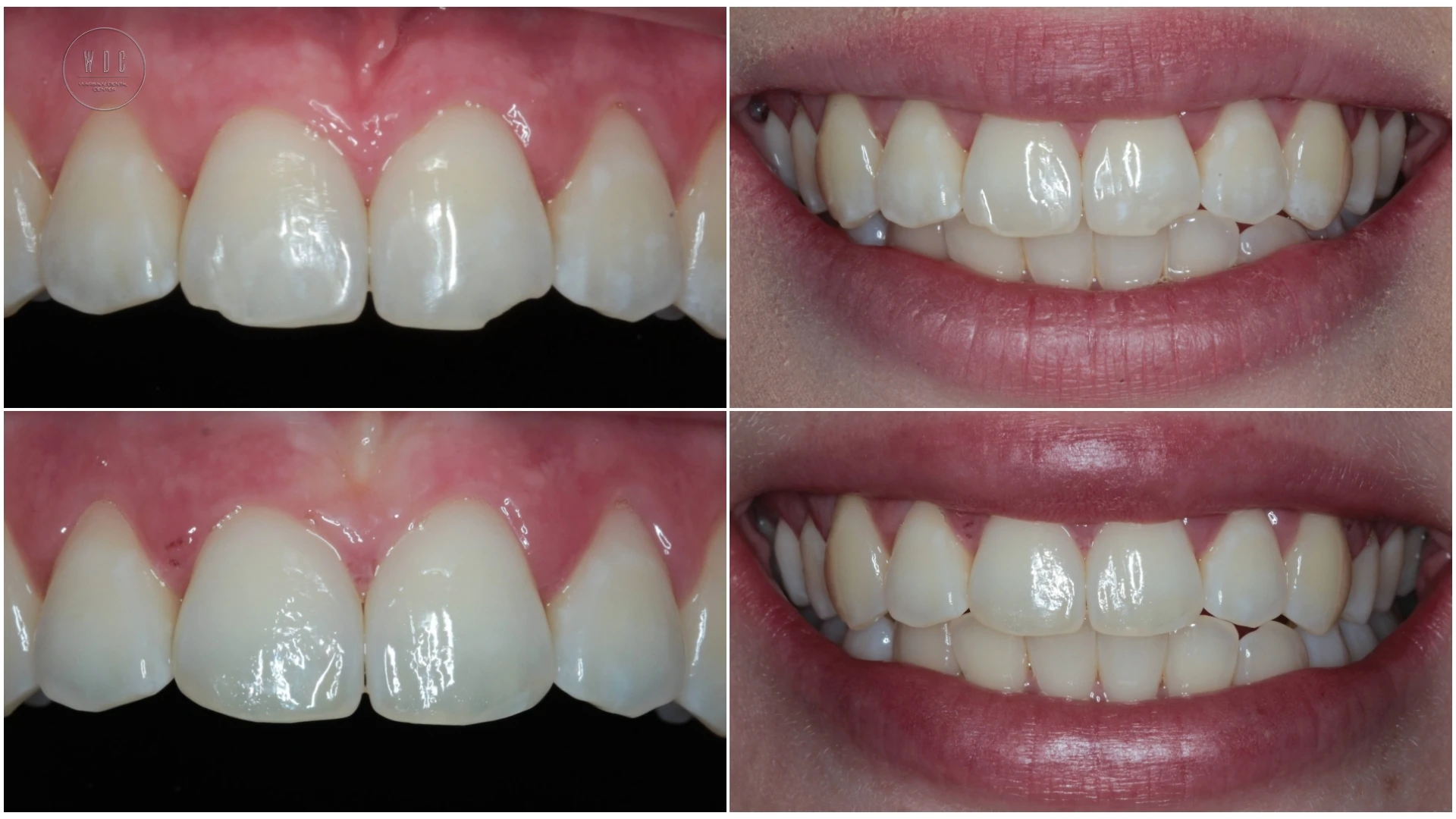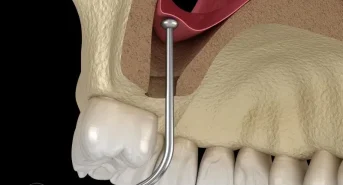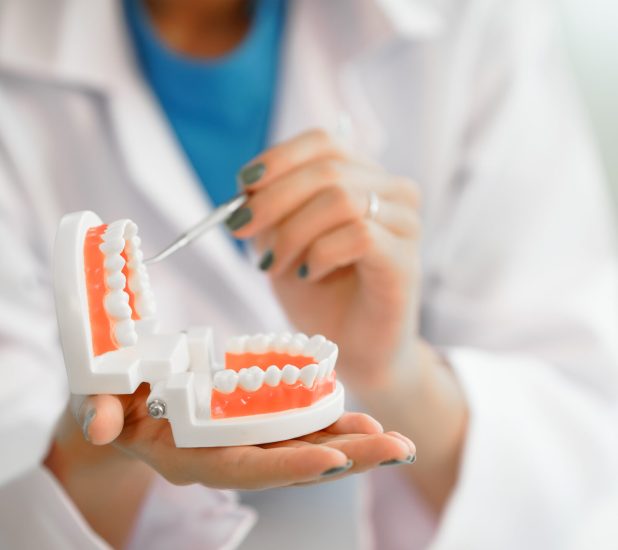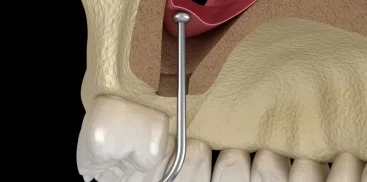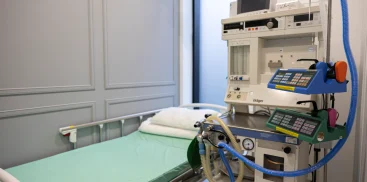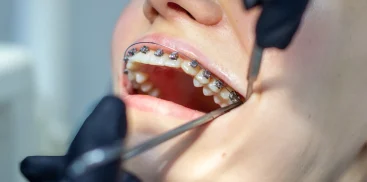Dr Natalia Rogulska patient success story
Beautiful smile and oral health without pain and discomfort? Sounds like a dream, right? Nowadays, dentistry has advanced significantly, offering innovative solutions that completely transform the dental experience. Modern dental clinics prioritize painless treatments as standard, with various conveniences available for anxious patients, such as sedation dentistry or procedures accompanied by favorite music. Cosmetic dentistry has also made great strides, allowing us to achieve a beautiful smile quickly and comfortably using solutions like composite or porcelain veneers.
What are Veneers?
A veneer is a thin covering that is bonded to the teeth to conceal imperfections such as fillings, discoloration, or to change the shape, lengthen, or widen teeth. They provide an efficient way to achieve a dream smile without lengthy treatments. Typically, applying veneers involves minimal tooth reshaping beforehand to ensure a natural appearance. At Warsaw Dental Center, dentists minimize tooth reshaping using microscopic magnification. This precision ensures minimal invasiveness while enhancing the aesthetic outcome.
Discover the Benefits of Dental Veneers: Who Should Consider Them?
Dental veneers offer a quick and effective cosmetic solution that significantly improves smiles. They are ideal for people with discoloration, minor imperfections like cracks or chips, and those seeking immediate results without prolonged orthodontic treatments. While versatile, veneers do not replace orthodontic treatment for more serious dental alignment issues. For those looking to enhance their smile cosmetically, veneers provide a durable and attractive solution tailored to individual aesthetic needs. Whether improving color, shape, or overall appearance, veneers can be customized to quickly achieve your cosmetic goals.
What Are the Contraindications for Veneers? Who Should Avoid Them?
Veneers are popular for smile enhancement but may not be suitable for everyone. Individuals who grind their teeth or have habits like clenching may need alternative options to prevent potential damage or detachment of veneers. Additionally, those who have undergone root canal treatment may not have sufficient tooth structure strength to support veneers. Lastly, individuals with gum disease, tooth decay, or significant bite alignment issues should address these dental concerns before considering veneers. Placing veneers on weakened or unhealthy tooth structures could exacerbate these conditions.
What Are the Advantages of Dental Veneers?
– Immediate Smile Enhancement: Veneers provide an instant improvement in smile appearance.
– Discomfort-Free Social Interactions: They allow you to enjoy a white smile without additional teeth whitening.
– Comprehensive Oral Health Care: At our clinic, we offer a wide range of cosmetic dentistry treatments, including porcelain, composite, and CAD/CAM veneers.
How Long Does It Take to Get Veneers?
You can achieve your dream smile in as few as three dental visits or even in one day with innovative CAD/CAM technology. Porcelain veneers offer a beautiful smile but require a bit more time. It’s crucial to assess your dental condition during consultation to determine if veneers are suitable or if other alternatives might be better.
What Are the Types of Dental Veneers?
When considering options for enhancing the appearance of front teeth, dental veneers stand out as a popular choice. These custom-made shells can dramatically transform your smile. Let’s explore the different types of veneers available, each suitable for specific needs and preferences:
– Porcelain Veneers: Thin ceramic shells meticulously crafted to match the front surface of your teeth. They closely mimic the natural light-reflecting properties of tooth enamel, making them virtually indistinguishable from your natural teeth. Ideal for covering stains, closing gaps, and correcting minor tooth misalignment.
– Composite Veneers: If you’re looking for a quicker and often more economical option, composite veneers may be suitable. Unlike porcelain veneers, which are fabricated in a dental lab and require multiple visits, composite veneers are molded directly onto your teeth during a single visit. While they can also deliver impressive results, composite veneers may be less durable and more prone to staining compared to porcelain.
– CAD/CAM Veneers: Innovative CAD/CAM veneers are crafted directly in our clinic. The manufacturing process takes only a few hours, allowing you to enjoy a new, perfect smile quickly. The color and shape of these veneers are customized to your specifications, with the entire design process occurring right before your eyes while you sit in the dental chair.
Understanding the different types of veneers—porcelain, composite, and CAD/CAM—enables you to make an informed decision about the best way to enhance your dental aesthetics. Each type offers unique benefits—from the durability and natural look of porcelain veneers to the convenience of composite veneers, all with minimally invasive characteristics. Your dentist can provide expert advice tailored to your oral health and aesthetic expectations.
What Is the Cost of Dental Veneers?
The cost of dental veneers—whether porcelain, composite, or CAD/CAM—depends on several factors. Each type of veneer has a different price point influenced by material costs, application complexity, and the patient’s dental condition. For an accurate quote tailored to your specific needs, it’s best to schedule a consultation. During this visit, you can receive a preliminary treatment plan outlining anticipated costs. This personalized plan considers details of your oral health and expected results.
Why Choose Veneers at Warsaw Dental Center?
Veneers crafted by Warsaw Dental Center specialists stand out in the cosmetic dentistry market primarily due to their minimally invasive approach. Here’s why they may be the superior choice:
– Painless Procedure: Tooth preparation for veneer placement is done under anesthesia and with the assistance of a microscope. This significant benefit caters to patients fearful of dental procedures.
– Minimal Impact on Tooth Structure: Veneers created in our clinic require minimal to no alteration of natural tooth structure. This gentle approach helps preserve the natural integrity of teeth while enhancing smile aesthetics.
– Personalized Design and Perfect Fit: Each set of veneers is custom-made in a specialized prosthetic laboratory. This personalized approach ensures perfect fit and exceptionally natural appearance.
– Quick Treatment Process: The entire veneer application process involves a maximum of three dental visits, making it not only effective but also convenient for patients with busy schedules.
Booking a veneer consultation at Warsaw Dental Center is straightforward. Simply contact the clinic to schedule a meeting at your convenience. During the initial visit, you’ll receive a personalized treatment plan tailored to your individual dental needs and preferences.
The Warsaw Dental Center team uses this opportunity to discuss various aspects of the procedure, including an estimated cost. We specialize in offering innovative, minimally invasive solutions.
This painless approach minimally impacts the natural structure of your teeth while significantly improving your smile’s appearance. If you’re keen on enhancing your smile with minimal disruptions, the consultation approach at Warsaw Dental Center ensures you get exactly what you need.
Article written on September 09, 2022 and updated on June 30, 2024 based on the latest technology and research.
